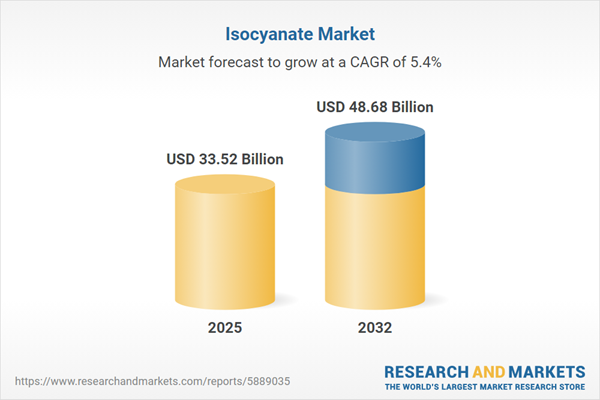Speak directly to the analyst to clarify any post sales queries you may have.
The isocyanate market is advancing rapidly as industries diversify their application of these vital chemicals in high-performance polymers, adhesives, elastomers, and coatings. Amid technological innovation and rigorous regulation, senior decision-makers face critical choices in product development, compliance, and supply chain optimization.
Isocyanate Market Snapshot
The isocyanate market grew from USD 31.89 billion in 2024 to USD 33.52 billion in 2025 and is forecasted to expand at a CAGR of 5.43%—reaching USD 48.68 billion by 2032. This trajectory demonstrates strong momentum fueled by increased demand for lightweight, high-performance and environmentally focused solutions across key industrial and consumer sectors, continuing to make isocyanate chemistry central to material innovation and manufacturing optimization.
Scope & Segmentation of the Isocyanate Market
- Type: Aliphatic isocyanates (including hexamethylene diisocyanate, isophorone diisocyanate) and aromatic isocyanates (methylenediphenyl diisocyanate, toluene diisocyanate).
- Process Technology: Both non-phosgene and traditional phosgenation processes are covered, addressing varying safety and environmental priorities across different production settings.
- Distribution Channel: Analysis includes both offline and online channels, with evolving models supporting specialty needs and bulk industrial purchases.
- Application: Key end uses encompass adhesives and sealants, elastomers, paints and coatings, and foams (flexible and rigid varieties), each supporting distinct performance and compliance requirements.
- End-User: Strategic demand drivers span automotive, construction, electronics, furniture, and healthcare, reflecting the sector’s wide-reaching relevance.
- Region: Regional analysis covers the Americas (United States, Canada, Mexico, Brazil, Argentina, Chile, Colombia, Peru); Europe, Middle East & Africa (United Kingdom, Germany, France, Russia, Italy, Spain, Netherlands, Sweden, Poland, Switzerland, United Arab Emirates, Saudi Arabia, Qatar, Turkey, Israel, South Africa, Nigeria, Egypt, Kenya); and Asia-Pacific (China, India, Japan, Australia, South Korea, Indonesia, Thailand, Malaysia, Singapore, Taiwan).
- Market Participants: Examined companies include Anderson Development Company, Asahi Kasei Corporation, Azelis group, BASF SE, BorsodChem, Covestro AG, Dow Chemical Company, Doxu Group, DuPont de Nemours, Inc., Evonik Industries AG, Huntsman International LLC, Kemipex Group, LANXESS AG, Merck KGaA, Mitsui Chemicals, Inc., Perstorp Holding AB, Tosoh Corporation, Umax Chemicals (shandong) Corporation, UPChem USA CO., LTD., Vencorex, and Wanhua Chemical Group Co., Ltd.
Key Takeaways: Strategic Insights for Decision-Makers
- Isocyanate chemistry now lies at the core of advanced material innovation, with unique reactivity driving polyurethane synthesis for diverse end markets.
- Regulatory pressure and sustainability commitments are increasing the adoption of non-phosgene manufacturing and bio-based feedstocks, especially in regions with strict environmental standards.
- Digital process optimization, including real-time analytics and digital twins, is creating operational efficiencies and reducing process risk across production lines.
- Strategic alliances, including OEM partnerships and collaborative ecosystems, are accelerating commercialization of custom solutions and enabling rapid adaptation to end-user demands.
- Regional shifts in policy, such as evolving emissions legislation and nearshoring trends, are influencing investment priorities and supply chain resilience strategies.
- Segmented solutions—spanning varied chemical types, process technologies, and verticals—are enabling companies to balance performance, compliance, and cost efficiencies for demanding applications.
Tariff Impact: United States Measures Reshape Supply Chains
The 2025 introduction of United States tariffs on isocyanate imports has catalyzed major adjustments to global sourcing and logistics. Domestic producers and end-users are reconfiguring feedstock supply strategies, while manufacturers are expanding local and regional production to mitigate trade-related uncertainty. These developments have accelerated nearshoring, led to renewed capacity investments in North America, and heightened the importance of long-term offtake agreements and risk-sharing models throughout the sector.
Research Methodology & Data Sources
This report integrates qualitative insights from industry experts with rigorous quantitative analysis. Primary data includes interviews with senior executives and technology providers, augmented by secondary sources such as industry publications and regulatory filings. Scenario modeling and data triangulation techniques validate findings, providing a robust basis for strategic planning.
Why This Report Matters for Senior Leaders
- Informs executive strategies by segmenting market opportunities and identifying critical regional and application-specific trends.
- Supports proactive risk management by illuminating the impact of evolving regulatory measures and supply chain disruptions.
- Guides capital allocation and R&D prioritization, enabling leaders to align investments with the fastest growing and most resilient market segments.
Conclusion
The isocyanate market stands at a pivotal stage, where technology, regulation, and supply chain evolution require clear strategic direction. This report empowers leaders to align innovation, compliance, and operational tactics for sustained, future-ready growth.
Additional Product Information:
- Purchase of this report includes 1 year online access with quarterly updates.
- This report can be updated on request. Please contact our Customer Experience team using the Ask a Question widget on our website.
Table of Contents
3. Executive Summary
4. Market Overview
7. Cumulative Impact of Artificial Intelligence 2025
Companies Mentioned
The companies profiled in this Isocyanate market report include:- Anderson Development Company
- Asahi Kasei Corporation
- Azelis group
- BASF SE
- BorsodChem
- Covestro AG
- Dow Chemical Company
- Doxu Group
- DuPont de Nemours, Inc.
- Evonik Industries AG
- Huntsman International LLC
- Kemipex Group
- LANXESS AG
- Merck KGaA
- Mitsui Chemicals, Inc.
- Perstorp Holding AB
- Tosoh Corporation
- Umax Chemicals (shandong) Corporation
- UPChem USA CO., LTD.
- Vencorex
- Wanhua Chemical Group Co., Ltd.
Table Information
| Report Attribute | Details |
|---|---|
| No. of Pages | 191 |
| Published | November 2025 |
| Forecast Period | 2025 - 2032 |
| Estimated Market Value ( USD | $ 33.52 Billion |
| Forecasted Market Value ( USD | $ 48.68 Billion |
| Compound Annual Growth Rate | 5.4% |
| Regions Covered | Global |
| No. of Companies Mentioned | 22 |









